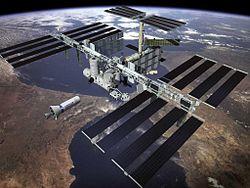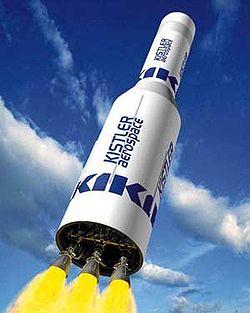
The Kistler K-1 was to have been a two-stage, fully reusable launch vehicle in commercial development by Rocketplane Kistler. It was designed to accommodate a wide range of missions, including payload delivery to low Earth orbit (LEO), payload delivery to high-energy orbits with a K-1 Active Dispenser, technology demonstration flights, microgravity missions, and commercial cargo resupply, recovery, and reboost services for the International Space Station.
After failing to meet financial milestones, NASA announced in October 2007 that it was terminating funding for the project.[1]
Reusability
The first stage of the vehicle would fly back to the launch site; the second would orbit Earth before returning. Recovery of the stages would be by parachutes and air bag.[2]
The 2nd stage would have a thermal protection system on top of the payload module.[3]
It was designed to be reused 100 times.[2]
Design
The first stage (18.3 m (60.2 ft) long, 6.7 m (22 ft) in diameter, and weighing 250,500 kg at launch) was called the Launch Assist Platform (LAP).[4][2]
The second stage (up to 18.6 m (61 ft) long with payload module, 4.3 m (14 ft) diameter cylinder, with flare at base, and weighed 131,800 kg fully fuelled) called the Orbital Vehicle (OV).[4]
Two stages, both to use AJ-26 engines using RP-1 and LOX.[3]
All variants of the payload module had a shallow dome with a thermal protection system. The dome could rotate to release payloads.[2]
Payloads
To the ISS it was planned for : 7000 lbs cargo upmass, and 2000 lbs cargo downmass.[4]
To LEO 12,500 lbs.
With an 'active dispenser' for payloads to higher orbits.
Progress on design and construction
Design started about 1994, and was complete enough for subcontracts by 1996. Originally planned to be in operation by 2000.
Major partners/subcontractors included :[2]
- Lockheed Martin: Tanks and Vehicle Assembly
- GenCorp Aerojet: Propulsion Systems
- Northrop Grumman: Vehicle Structure
- Draper Laboratory: Guidance: Navigation and Control and Mission Control System
- AlliedSignal Aerospace: Vehicle Management System
- Irvin Aerospace: Landing System (parachutes, and maybe airbags)
- Oceaneering Thermal Systems: Thermal Protection System
- Reynolds, Smith, and Hills/Leighton Contractors: Launch Facility
The first K-1 vehicle build was said to be 75% complete in August 2004, with design 85% complete, and the first guidance, navigation and control (GN&C) flight software 100% complete.[3]
See also
- Commercial Orbital Transportation Services
- List of private spaceflight companies#Crew and cargo transport vehicles
- List of space launch system designs
- Rocketplane Limited, Inc.
References
- ^ Berger, Brian (2007-09-07). "NASA Gives Rocketplane Kistler Termination Notice". Space.com.
- ^ a b c d e Description of Kistler K-1 on Astronautix Archived 2010-03-24 at the Wayback Machine
- ^ a b c Kistler K-1 Program Status: First Vehicle 75% Complete
- ^ a b c ACCESS TO SPACE FOR EXPLORATION MISSIONS USING REUSABLE LAUNCH VEHICLES
